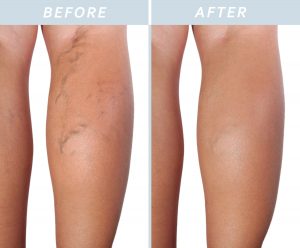
Cosmetic Vein Treatments
Spider veins can be treated a number of ways including with laser, intense pulsed light, radio frequency wavelength and with injections of medicine called sclerotherapy. Several options are available for the treatment of venous reflux (backflow) and varicose veins. Each has its advantages and disadvantages. After your consultation and ultrasound evaluation, our vein specialists will recommend the best plan of treatment for your medical or cosmetic needs.
Sclerotherapy for Spider Veins
Superficial leg veins, sometimes called “spider veins” occur when tiny veins congregate below the surface of the skin, causing red, blue or purple discolorations. Spider veins get their name from the shape of the discolorations. Some cases of spider veins can be quite small. Others are more noticeable. They may make you feel self-conscious, but they are harmless, and any treatment is usually done for cosmetic reasons only.
Other types of problematic veins that can appear similar to spider veins include:
- Telangiectasias, which are dilated capillaries close to the skin, tend to be more noticeable on the face, whereas spider veins more commonly occur on the legs and feet
- Hemangiomas and angiomas, which are made up of very small arteries called arterioles or very small veins called venules.
- Sometimes, the terms spider veins and telangiectasias are used interchangeably.
- Red or bluish-purple blood vessels appear, usually on the legs or thighs, but sometimes on the face, forearms or hands. Spider veins usually do not cause any symptoms, but rarely may cause a mild dull discomfort or burning sensation.
The two most common cosmetic treatments for spider veins are sclerotherapy and laser treatment.
Sclerotherapy involves having a medication injected directly into the affected area, causing the veins to collapse. The area may be tender for a few days and it may bruise, but bruising should fade over a few weeks. Sclerotherapy may require multiple treatments.
The injections can be slightly painful.Sclerotherapy is an important adjunct and is frequently the treatment of choice for spider vein removal because the desired result is quicker to achieve and less expensive for most patients. Sclerotherapy is used in over 90% of vein centers specializing in the treatment of spider veins because the results are usually superior and less costly. Dr. Omar Torres will recommend the best treatment plan for your spider veins after discussing all of these options.
Other Vein Treatments
Spider veins are most common on the thighs, ankles and calves, and are more common in women than men. Their cause isn’t completely understood in every case, but they can run in families. Some cases are related to pregnancy, use of birth control pills or weight gain.
Laser treatment directs pulses from a laser light to the spider veins, causing tiny blood clots to form. The blood vessels become blocked off and eventually are reabsorbed by the body.
Sometimes a combination of treatments is required to get the best results. The medications that are FDA approved for spider vein injections are Sotradecol and Polidocanol. People often ask if we use saline but it is rarely utilized anymore by any vein practices in this country because of the side effects, pain and complications involved with saline injections.
Frequently Asked Questions
What generally happens to spider and varicose veins?
In the majority of cases, the spider and varicose veins worsen with time. The spider veins start to become more prominent and swell. With time, the veins are engorged with blood and can cause localized pain and itching. Once the veins become prominent, it is very unlikely that they will spontaneously resolve without any treatment.
What causes spider and varicose veins?
The cause of spider and varicose veins is unknown but is definitely linked to increase pressure in the veins. There are valves in the veins which prevent the back flow of blood back into the legs. When these valves become damaged/defective, the blood flows backwards and causes swelling and engorgement of the veins.
Can one prevent spider and varicose veins?
If one starts early in life, varicose veins can be prevented. The major preventive measure is to exercise and wear compression stockings.
- Elevation of the legs at all times is also recommended.
- During pregnancy, one should always lie on the left side with the legs elevated on a pillow. This prevents the fetus from pressing on the leg veins and decreases the chance of developing varicosities.
- One should avoid standing for prolonged periods.
- Don’t cross your legs when sitting down.
- Wear elastic support stockings.
We Can Help You
Call us to schedule your appointment today at (212) 673-5633 or visit us at one of our conveniently located New York offices to learn more about our extensive line of cosmetic dermatology procedures and how they could transform your appearance.

